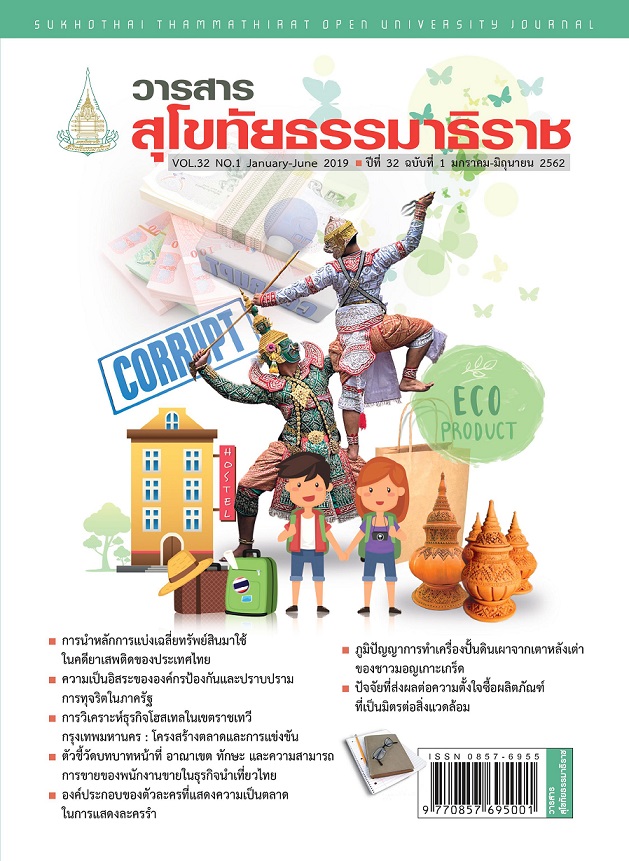ตัวชี้วัดบทบาทหน้าที่ อาณาเขต ทักษะ และความสามารถการขายของ พนักงานขายในธุรกิจนำเที่ยวไทย
คำสำคัญ:
แรงขับเคลื่อนการขาย, บทบาทหน้าที่และอาณาเขต, ทักษะและความสามารถ, ธุรกิจนำเที่ยวไทยบทคัดย่อ
การวิจัยนี้มีวัตถุประสงค์เพื่อ 1) ศึกษาระดับบทบาทหน้าที่และอาณาเขตขายรวมถึงทักษะความสามารถ จากแรงขับเคลื่อนการขายของพนักงานขายในธุรกิจนำเที่ยวไทย 2) พัฒนาและตรวจสอบความตรงของตัวชี้วัด บทบาทหน้าที่และทักษะความสามารถการขายของพนักงานขายในธุรกิจนำเที่ยวไทย โดยอาศัยการวิเคราะห์ การแจกแจงความถี่ ค่าเฉลี่ย ค่าร้อยละ ค่าส่วนเบี่ยงเบนมาตรฐาน และองค์ประกอบเชิงยืนยันอันดับสอง เป็นการวิจัยเชิงสำรวจและพัฒนาโดยใช้แบบสอบถามจากผู้ประกอบการธุรกิจนำเที่ยวในประเทศไทย 1,110 ราย การสุ่มตัวอย่างโดยวิธีหลายขั้นตอนตามประเภทธุรกิจนำเที่ยวแห่งละ 3 ราย ด้วยเทคนิคแบบโควตา ผลการวิจัยพบว่า กลุ่มตัวอย่างพนักงานขายมีความคิดเห็นต่อการขายในธุรกิจนำเที่ยวไทยในระดับมาก ด้านบทบาทหน้าที่และอาณาเขตและทักษะความสามารถ ตัวชี้วัดบทบาทหน้าที่และทักษะความสามารถ การขายของพนักงานขายในธุรกิจนำเที่ยวไทยที่พัฒนาขึ้นมีความกลมกลืนกับข้อมูลเชิงประจักษ์ประกอบด้วย 10 ตัวชี้วัดจาก 2 องค์ประกอบ ได้แก่ องค์ประกอบที่ 1 บทบาทหน้าที่และอาณาเขต จำนวน 5 ตัวชี้วัด และองค์ประกอบที่ 2 ทักษะความสามารถ จำนวน 5 ตัวชี้วัด ซึ่งในแต่ละองค์ประกอบต่างมีความตรง เชิงเสมือน ทั้งนี้เนื่องจากค่าความเชื่อมั่นเชิงโครงสร้างผ่านเกณฑ์มากกว่า 0.60 และให้ค่านํ้าหนักองค์ประกอบ ตั้งแต่ 0.30 ขึ้นไป (ค่าสัมบูรณ์) ที่ความสำคัญทางสถิติ 0.05
References
Management, 37, 27-41.
Agyeiwaah, E., Adongo, R., Dimache, A., & Wondirad, A. (2016). Make a customer, not a sale: Tourist satisfaction in Hong Kong. Tourism Management, 57, 68-79.
Andreas, W., James, A.M., Tassilo, D. M., Julia, J., & Gerhard, B. (2017). Conscientiousness, extraversion and field sales performance: Combining narrow personality, social skill, emotional stability and nonlinearity. Personality and Individual Difference, 104, 291-296.
Arbuckle, J. J. (1995). AMOS user’s guide. Chicago: Small Waters Corporation.
Barrette, J. (2012). B2B Customer Insight: The proven path to growth. United States of America: Information Age Publishing, Inc.
Bodla, M. A., & Naeem, B. (2014). Creativity as mediator for intrinsic motivation and sales performance. Creativity Research Journal, 26(4), 468-473.
Bollen, K. A. (1989). Structure Equations with Latent Variables. New York: John Wiley & Sons.
Browne, M. W., & Cudeck, R. (1993). Alliterative Ways of Assessing Model Fit, in Testing Structural Equation Model. New Jersey: Sage Publication.
Cochran, W. G. (1977). Sampling Techniques. (3rded.). New York: John Wiley & Sons, 1-2.
Davidson, J. (2017). Micro-Tasking for effective selling. Marketing and Alliance Excellence Essentials, 17(6), 15.
Ekerdt, D. J., & Addington, A. (2015). Possession divestment by sales in later life. Journal of Aging Studies, 34, 21-28.
Evans, K., & Maio, C. F. (2011). Sales Force-Generated Marketing Intelligence. In D. Cravens, K. Le Meunier-FitzHugh, & N. F. Piercy (Eds.), The Oxford handbook of strategic sales and sales management. Oxford: Oxford University Press.
Galina, L., & Ekaterina, S. (2015). Territory management in view of cluster potential. Procedia Economics and Finance, 27, 216-223.
Garrett, T. (1966). Business Ethics. NJ: Prentice-Hall, Englewood Cliffs.
Hildesheim, A. (2011). Internal Knowledge Exploitation: The Role of Sales Force Integration in New Product Development (Dissertation). Germany, DE: University of Mannheim.
Inamizu, N., Sato, H., & Ikuine, I. (2017). Five steps in sales and its skills: The Importance of Preparing before an Interview with customers. Annals of Business Administrative Science, 16, 1-13.
Joreskog, K. G., & Sorbom, D. (1993). Lisrel 8: Structural Equation Modeling with the Simplis Command Language. Chicago: Software International.
Kahle, D. (2017). Transforming your sales force by creating specific expectations. American Salesman, 62(4), 20-25.
Katsikea, E., Theodosiou, M., & Morgan, R. (2007). Managerial, Organizational and External Drivers of Sales Effectiveness in Export Market Ventures. Journal of the Academy of Marketing Science, 35(2), 270-283.
Khuharattanachai, C. (2003). Introduction to Statistics. Bangkok: Department of Statistics, Mahanakorn Technical University, 7-10. (in Thai)
Koch, S. (2016). Decision-Making in Solution Selling Situations the Role of Multi-Actor Expectations in the Sales Process. Master, Eindhoven University of Technology.
Kotler, P., & Keller, K. L. (2012). Marketing Management (14th ed.). New Jersey: Pearson, Prentice Hall.
Liu, A., Leach, M., & Chugh, R. (2015). A sales process framework to regain B2B customers. Journal of Business & Industril Marketing, 30(8), 906-914.
Manager 360˚. (2015). Tourism in the middle of the monsoon of Thailand. Retrieved November 18, 2017, from http://www.gotomanager.com/content/การท่องเที่ยวไทย-กลางมรสุมของการแข่งขัน. (in Thai)
Mckinsey and Company Inc. (2016). Sales Growth: Five Proven Strategies From the World’s Sales Leaders. (N.p.): Wiley.
Munyon, T. P., Summers, J. K., Thompson, K. M., & Ferris, G.R. (2015). Political skill and work outcome: A theoretical extension, meta-analytic investigation and agenda for the future. Personnel Psychology, 68, 143-184.
Murphy, P. (2011). Inspiration for sale. Paraplegia News, 65(9), 52.
Office of Tourism. (2017). Guide business statistics at 31 March 2017. Retrieved April 2nd, 2017, from http://www.tourism.go.th/view/1/หน้าแรก/TH-TH. (in Thai)
Piercy, N. F., & Lane, N. (2009). Strategic Customer Management: Strategizing the Sales Organization. New York: Oxford University Press.
Rentz, J. O., Shepherd, D. C., Tashchian, A., Dabholkar, P. A., & Ladd, R. T. (2002). A measure of selling skill: Scale development and validation. Journal of Personal Selling & Sales Management, 22(1), 13-21.
Ross, W. D. (1930). The Right And the Good. Oxford: Clarendon Press.
Saentong, N. (2014). Modern Personnel Management Performance (4th ed.). Bangkok: H.R. Center Publication. (in Thai)
Shaalan, A. S., Reast, J., Johnson, D., & Tourky, M. E. (2013). East meets west: Toward a theoretical model linking guanxi and relationship marketing. Journal of Business Research, 66, 2515-2521.
Thomson, S. K. (1992). Sampling. New York: John Wiley & Sons, 34.
Tsvetkov, A. Y. (2016). Mission in the strategic territory management (on the example of the Solovetsky archipelago). Arctic and North, 23, 44-49.
Tweneboah-Koduah, I., Adusei, C., & Tenkorang, C. (2016). Sales territory management and distributor performance in the telecommunications industry in Ghana. Expert Journal of Marketing, 4(2), 46-59.
Vanichbuncha, K. (2006). Advanced Statistics, with SPSS for Windows (5th ed.). Bangkok: Chulalongkorn University, 79-110. (in Thai)
Viratchai, N. (1999). The Linear Relationship (LISREL): Statistic for Social Science and Behavioral Sciences. Bangkok: Chulalongkorn University Printing, 32, 84. (in Thai)
Vongnaree, M. (2011). How to Motivate Man to Work to Get Work Result. Bangkok: Public Work Journal. (in Thai)
Weeks, W. A., & Nantel, J. (1992). Corporate codes of ethics and sales force behavior: A case study. Journal of Business Ethics, 11, 753-760.
Wei, L. Q., Liu, J., Chen, Y. Y., & Wu, L. Z. (2010). Political skill, supervisor-subordinate guanxi and career prospects in Chinese firms. Journal of Management Studies, 47, 437-454.
Zoltners, A. A., Sinha, A. P., & Lorimer, S. E. (2004). Sales Force Design for Strategic Advantage. NY: Palgrave Macmillan, 315-317.
Downloads
เผยแพร่แล้ว
How to Cite
ฉบับ
บท
License
บทความที่ได้รับการตีพิมพ์เป็นลิขสิทธิ์ของวารสารมหาวิทยาลัยสุโขทัยธรรมาธิราช
ข้อความที่ปรากฏในบทความแต่ละเรื่องในวารสารวิชาการเล่มนี้เป็นความคิดเห็นส่วนตัวของผู้เขียนแต่ละท่านไม่เกี่ยวข้องกับมหาวิทยาลัยสุโขทัยธรรมาธิราช และคณาจารย์ท่านอื่นๆในมหาวิทยาลัยฯ แต่อย่างใด ความรับผิดชอบองค์ประกอบทั้งหมดของบทความแต่ละเรื่องเป็นของผู้เขียนแต่ละท่าน หากมีความผิดพลาดใดๆ ผู้เขียนแต่ละท่านจะรับผิดชอบบทความของตนเองแต่ผู้เดียว
ห้ามนำข้อความทั้งหมด หรือบางส่วนไปพิมพ์ซ้ำ เว้นแต่จะได้รับอนุญาตจากกองบรรณาธิการวารสาร


